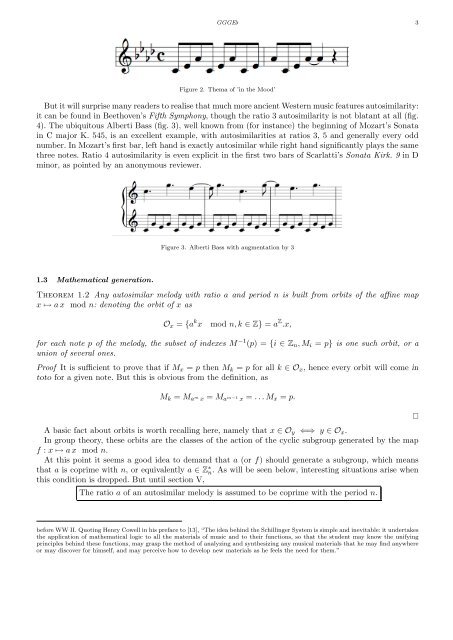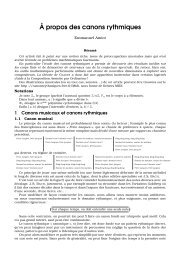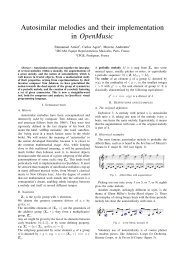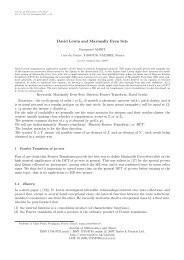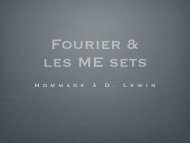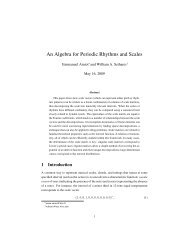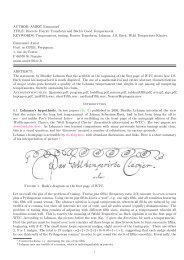Emmanuel Amiot Modèles algébriques et algorithmes pour la ...
Emmanuel Amiot Modèles algébriques et algorithmes pour la ...
Emmanuel Amiot Modèles algébriques et algorithmes pour la ...
You also want an ePaper? Increase the reach of your titles
YUMPU automatically turns print PDFs into web optimized ePapers that Google loves.
GGGE♭ 3<br />
Figure 2. Thema of ’in the Mood’<br />
But it will surprise many readers to realise that much more ancient Western music features autosimi<strong>la</strong>rity:<br />
it can be found in Be<strong>et</strong>hoven’s Fifth Symphony, though the ratio 3 autosimi<strong>la</strong>rity is not b<strong>la</strong>tant at all (fig.<br />
4). The ubiquitous Alberti Bass (fig. 3), well known from (for instance) the beginning of Mozart’s Sonata<br />
in C major K. 545, is an excellent example, with autosimi<strong>la</strong>rities at ratios 3, 5 and generally every odd<br />
number. In Mozart’s first bar, left hand is exactly autosimi<strong>la</strong>r while right hand significantly p<strong>la</strong>ys the same<br />
three notes. Ratio 4 autosimi<strong>la</strong>rity is even explicit in the first two bars of Scar<strong>la</strong>tti’s Sonata Kirk. 9 in D<br />
minor, as pointed by an anonymous reviewer.<br />
1.3 Mathematical generation.<br />
Figure 3. Alberti Bass with augmentation by 3<br />
Theorem 1.2 Any autosimi<strong>la</strong>r melody with ratio a and period n is built from orbits of the affine map<br />
x ↦→ a x mod n: denoting the orbit of x as<br />
Ox = {a k x mod n, k ∈ Z} = a Z .x,<br />
for each note p of the melody, the subs<strong>et</strong> of indexes M −1 (p) = {i ∈ Zn, Mi = p} is one such orbit, or a<br />
union of several ones.<br />
Proof It is sufficient to prove that if Mx = p then Mk = p for all k ∈ Ox, hence every orbit will come in<br />
toto for a given note. But this is obvious from the definition, as<br />
Mk = Ma m x = Ma m−1 x = . . . Mx = p.<br />
A basic fact about orbits is worth recalling here, namely that x ∈ Oy ⇐⇒ y ∈ Ox.<br />
In group theory, these orbits are the c<strong>la</strong>sses of the action of the cyclic subgroup generated by the map<br />
f : x ↦→ a x mod n.<br />
At this point it seems a good idea to demand that a (or f) should generate a subgroup, which means<br />
that a is coprime with n, or equivalently a ∈ Z ∗ n. As will be seen below, interesting situations arise when<br />
this condition is dropped. But until section V,<br />
The ratio a of an autosimi<strong>la</strong>r melody is assumed to be coprime with the period n.<br />
before WW II. Quoting Henry Cowell in his preface to [13], “The idea behind the Schillinger System is simple and inevitable: it undertakes<br />
the application of mathematical logic to all the materials of music and to their functions, so that the student may know the unifying<br />
principles behind these functions, may grasp the m<strong>et</strong>hod of analyzing and synthesizing any musical materials that he may find anywhere<br />
or may discover for himself, and may perceive how to develop new materials as he feels the need for them.”


